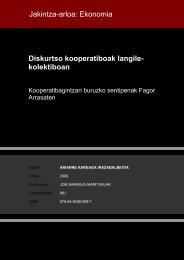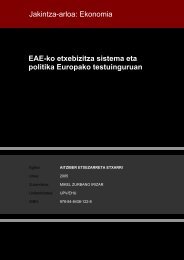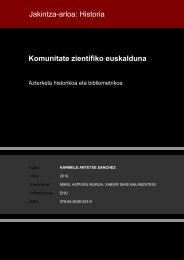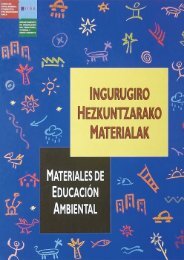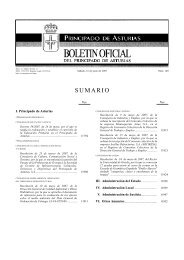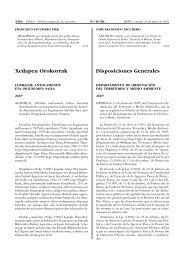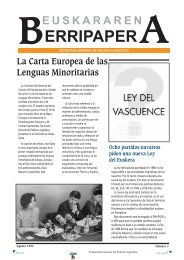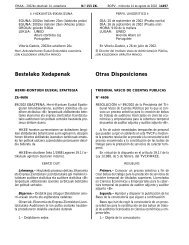Sinterizazio-atmosferaren eragina M graduko (ASP 30 ... - Euskara
Sinterizazio-atmosferaren eragina M graduko (ASP 30 ... - Euskara
Sinterizazio-atmosferaren eragina M graduko (ASP 30 ... - Euskara
Create successful ePaper yourself
Turn your PDF publications into a flip-book with our unique Google optimized e-Paper software.
Table 4 MX carbonitride compositions, at .-%<br />
Steel grade V W + Mo Fe + Co<br />
M3/2 81 3 11<br />
Px<strong>30</strong> 75 8 11<br />
M2 81 2 11<br />
M42 80 5 9<br />
with high precision . Table 1 summarises the chemical<br />
compositions of the M 6C primary carbides found in the<br />
different steels after sintering at the optimum temperature<br />
both in vacuum and in the industrial atmosphere .<br />
Although there are individual differences due to the different<br />
chemical compositions, adding W + Mo and Fe + Co<br />
gives practically constant values . However, although the<br />
chemical composition of the M6C carbides is very similar<br />
after sintering in the industrial atmosphere and in vacuum,<br />
the V concentration is lower in the industrial atmosphere<br />
sintered material . This is due to the higher concentration<br />
of this element found in the MX carbonitrides, as mentioned<br />
above . The table also gives the chemical composition<br />
of M 6 C carbides analysed by other authors in M2<br />
and M7 vacuum sintered steels, with almost identical<br />
values to those found in the present work for vacuum<br />
sintering . The mean stoichiometric composition of these<br />
carbides is (Fe,Co) 3(W,Mo)7. 5 (V,Cr)0 .5C. Exactly the<br />
same composition of M6C carbides has recently been<br />
found for T grade steel .'<br />
MC primary carbides, MX carbonitrides<br />
The size of the primary MC carbides (> 4 µm) was sufficient<br />
to allow analysis without matrix interference in steels<br />
with a V composition equal to or higher than 3 wt-% .<br />
Vacuum sintered M2 and M42 steels presented MC carbides<br />
in the form of thin films . In these conditions, the<br />
effect of matrix interference in the chemical analysis was<br />
very clear (Table 2) . The chemical composition of the MC<br />
carbides for the various vacuum sintered steels is given in<br />
Table 3 where it can be seen that although the relative<br />
amounts of W and Mo are different, due to the different<br />
compositions of the steels, the sum of W + Mo is almost<br />
the same . This has also been observed in several T type<br />
steels .' It can also be seen that the more important<br />
metallic element in this carbide is V and that Co is not<br />
present . Similar carbide compositions have been reported<br />
by Karag6z et al."<br />
When the steels are sintered in the industrial atmosphere<br />
containing N2, the incorporation of nitrogen transforms<br />
the MC carbides to carbonitrides, as reported by<br />
Palma et al .' This is due to the higher stability of the<br />
nitride than the carbide . Table 4 summarises the chemical<br />
compositions (metallic elements) of the carbonitrides present<br />
in the different steels analysed in the present work .<br />
Again the compositions are very similar for the different<br />
steels and if the results are compared with those for the<br />
MC carbides, a significant increase in the amount of V in<br />
Table 5 M2C carbide compositions, at.-%<br />
Steel Mo V Cr Fe W W+Mo<br />
M42* 39 23 11 15 11 50<br />
<strong>ASP</strong>60t' 8 31 2 49 9 8 39<br />
M220 21 23 14 12 26 46<br />
M2 16 36 21 12 7 23 59<br />
M7, primary 17<br />
M7, primary<br />
<strong>30</strong> 19 9 39 3 33<br />
17<br />
39 23 10 25 4 43<br />
* Present work .<br />
t Secondary carbides, atom probe .<br />
Urrutibeaskoa et al. Metallographic changes on sintering M grade steels 311<br />
Table 6 Eutectic type 1 carbide compositions, at .-%<br />
Steel Mo V Cr Fe Co W W + Mo Co + Fe<br />
M3/2* 24 28 27 17 . . . 4 28 17<br />
M3/2+N* 28 11 27 28 . . . 7 35 28<br />
Px<strong>30</strong>* 25 19 12 27 2 15 40 29<br />
Px<strong>30</strong> + N* 23 12 13 37 3 12 35 40<br />
M2* 23 19 20 33 . . . 5 28 33<br />
M2+N* 22 9 27 36 . . . 6 28 36<br />
M2 M23C6 ' 4 8 50 37 . . . 2 6 37<br />
M2 EMC + M6C 1 2 <strong>30</strong> 26 13 13 . . . 18 48 13<br />
M42* 34 16 19 28 1 2 36 29<br />
M42 + N* 26 6 17 46 4 2 28 50<br />
* Present work .<br />
the MX carbonitride is observed . Similar results have been<br />
obtained with several T type HSS .' a<br />
M2C carbides<br />
The primary M2C carbide, with its typical rectangular<br />
elongated aspect (Fig . 7), was found only in steel M42<br />
which had a higher Mo content . It can be differentiated<br />
from the M 6 C carbide by its chemical composition, given<br />
in Table 5, which compares the chemical composition of<br />
the M,C found in this work with other compositions<br />
reported in the literature . 1B.17 .18 This carbide has also been<br />
identified by X-ray diffraction and distinguished from M6C<br />
by the presence of a (0001) reflection in vacuum sintered<br />
materials, which was not found after sintering in the<br />
nitrogen based atmosphere ." This could indicate that the<br />
presence of nitrogen in the steel either prevents the formation<br />
ofW carbides, or favours the decomposition of M2C<br />
carbides to M6C and MC carbides, as has been reported by<br />
17 .18<br />
other authors . 16,<br />
Eutectic carbides<br />
The type MC and M 6C eutectic carbides found in the<br />
present specimens show chemical compositions close to<br />
those observed in the primary carbides of the same types .<br />
However, MC carbides were not observed in steels sintered<br />
in the industrial atmosphere . This could be because<br />
in the nitrogen rich industrial atmosphere the MC carbides<br />
are transformed to MX carbonitrides and the possible<br />
transformation on cooling of the liquid to MX and austenite,<br />
which happens when MC carbide is formed, disappears<br />
or is shifted to much higher temperatures . This type<br />
of MC eutectic carbide was not observed in M42 steel, due<br />
to the low V content of the steel . The presence of M 6C<br />
eutectic carbides both under vacuum and in the industrial<br />
atmosphere seems to define the limit of adequate sintering<br />
. The addition of carbon or the introduction of nitrogen<br />
through the atmosphere does not greatly affect the temperature<br />
at which the first M 6C appears in each steel .<br />
However, because both the addition of carbon and the<br />
introduction of nitrogen in steels M3/2 and Px<strong>30</strong> decreases<br />
the optimum sintering temperature, an increase in the<br />
concentration of carbon, and occasionally nitrogen, in the<br />
steel in the cases mentioned above could have enlarged the<br />
sintering `gate' .<br />
The composition and morphology of the needle type<br />
eutectic carbide found in the M3/2, Px<strong>30</strong>, and M2 steels<br />
after oversintering in vacuum is similar (adding W + Mo)<br />
to that found for M2C primary carbide in M42 steel and for<br />
a carbide identified as M,C in M2 .16 .19, 2°<br />
Other<br />
workers"- '7 . 15 have shown that M 2 C carbides are unstable<br />
and decompose during cooling to M6C and MC . In the<br />
present work the cooling rate was very high and possibly<br />
explains why this decomposition did not take place . To<br />
confirm this hypothesis, a M2+0 . 2%C sample was cooled<br />
slowly in the furnace (20 K h - ') after oversintering by<br />
Powder Metallurgy 1990 Vol . 33 No . 4



